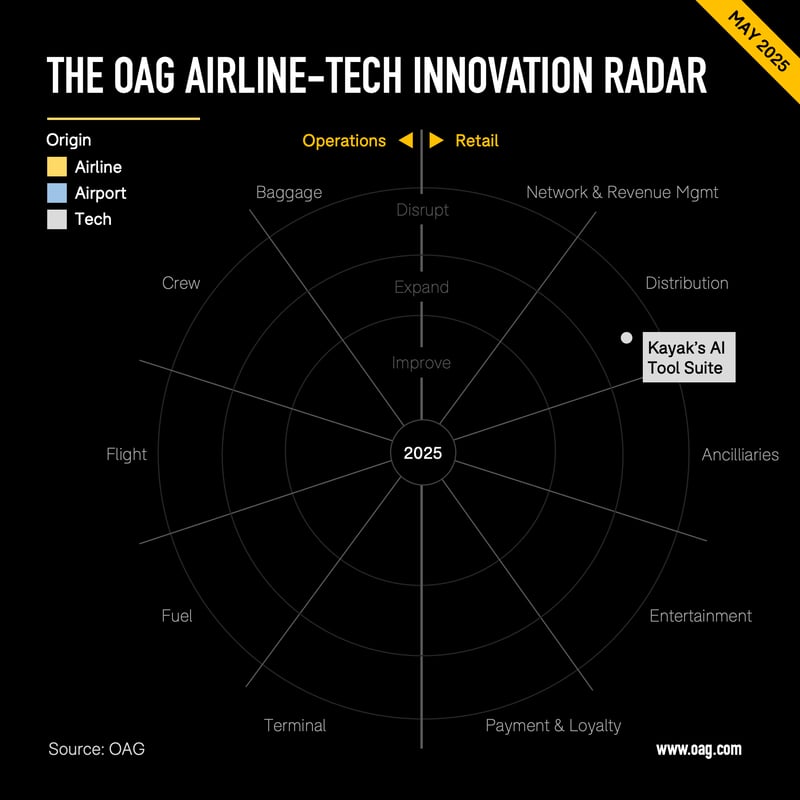As we slowly approach the halfway point of the year, the airline industry continues to grapple with shifting geopolitical risks and volatile travel demand. Yet, innovation is showing no signs of slowing. If anything, the past few weeks have demonstrated how determined both established players and challengers are to rethink core elements of the air travel experience.
From bold moves in AI-powered trip planning to foundational upgrades in how airlines operate behind the scenes, this month’s new product launches reflect a mix of ambition, speed, and long-term vision.
Here are the three innovations we believe best capture that momentum:
Innovation #1: Kayak Reimagines Travel Planning with New AI Suite
Kayak has introduced a suite of new AI-powered tools aimed at making travel planning more intuitive and personalized. At first glance, this might seem like a standard ChatGPT-powered industry update. After all, numerous travel booking platforms (including many airlines and OTAs) now utilize AI chatbots to handle natural language search queries. However, Kayak’s recent “Ask Kayak” initiative represents a promising step forward in genuinely redefining travel search.
Here’s how it works:
“Ask Kayak” enables users to search using conversational language, for instance, “Where can I fly nonstop from Berlin for under €300?” But Kayak’s innovation doesn’t stop there. The company has also introduced several connected features that significantly elevate the user experience:
- KAYAK PriceCheck: Users can upload a screenshot of a flight itinerary from any travel website. Kayak processes the image, automatically analyzing and comparing prices across multiple platforms to ensure users secure the best available deal.
- Provider Quality Scores: Kayak assesses and ranks travel booking sites based on critical factors such as pricing accuracy and overall customer satisfaction, guiding travelers toward more informed booking decisions.
- Enhanced Itinerary Management: Currently available only to iOS users, this tool provides a simplified, real-time view of travel plans, significantly improving itinerary handling.
Why does this innovation stand out?
Kayak’s AI launch transcends the typical incremental updates commonly seen in the travel search space since the introduction of Generative AI. Rather than merely transitioning from keyword-based searches to conversational interfaces (as many competitors have done), Kayak integrates advanced tools that directly address long-standing pain points (such as the ongoing difficulty of comparing offers from multiple websites). This indicates a far deeper reimagining of travel metasearch.
Moreover, Kayak has embraced a notably riskier and costlier strategy by developing an entirely new platform (kayak.ai) rather than simply augmenting its existing website. Described by Kayak’s CEO as the company’s “new test lab,” this bold initiative underscores its serious commitment to revolutionizing the booking experience.
Could Kayak’s ambitious strategy signify the first genuine AI disruption toward seamless and personalized travel interactions – something the industry has pursued for years?
If so, airlines should closely monitor these developments, as Kayak’s innovations could provide critical insights into the future evolution of airline.com websites and customer interactions.
Innovation #2: Fliggy Launches Agentic AI for Fully Bookable Travel Itineraries
Following Kayak’s reimagining of the metasearch experience, our second innovation comes from the other side of the globe, China. Online travel agency Fliggy (a part of Alibaba Group) is pushing the boundaries of AI-powered travel planning with the launch of its new assistant: AskMe.
Here’s how it works:
Unlike typical ChatGPT-style interfaces, AskMe is powered by a system of intelligent agents designed to emulate the task execution and problem-solving abilities of professional travel consultants.
- Users simply enter a request, such as a trip idea, destination, or constraint, and AskMe autonomously breaks the task into sub-components and activates specialized AI agents accordingly.
- These sub-agents analyze the user’s needs and pull live information from Fliggy’s real-time pricing engine, including flights, hotels, routes, attractions, and even dining recommendations, to create coherent, cost-optimized, fully bookable itineraries.
The assistant leverages Fliggy’s proprietary travel datasets and runs on Alibaba’s in-house Qwen AI models. This setup ensures extremely low hallucination rates, as the system relies on verified, high-quality scenario data from within Fliggy’s platform, not inaccurate third-party sources.
The output? A visually rich, multi-day itinerary with images, product details, maps, and direct booking links. AskMe also supports voice input in multiple dialects and even allows users to generate hand-drawn-style travel guides for social media sharing.
Why does this innovation stand out?
- Fliggy’s AskMe goes far beyond basic conversational interfaces. By simulating a team of task-specific assistants, it performs complex planning and coordination, something traditionally only offered by high-end human travel consultants.
- Fliggy’s deep integration of AI with its proprietary pricing and inventory engine creates a level of accuracy and bookability that most travel assistants struggle to match. In benchmark tests across five key areas (measuring accuracy, coherence, richness, utility, and customization), AskMe scored highest in accuracy and coherence, setting a new standard in functional GenAI travel applications.
- What used to be a luxury, fully personalized, multi-day travel planning, is now accessible to everyday users. AskMe turns overwhelming travel complexity into an intuitive experience, closing the gap between inspiration and execution.
In short, Fliggy’s AskMe is a powerful reminder that building smarter AI travel agents isn’t just about fancy interfaces; it’s about connecting AI capabilities to rich, reliable, and real-time data ecosystems via agentic workflows that truly differentiate the traveler experience.

Innovation #3: Singapore Airlines Embraces a Multi-Partner AI Strategy
While the first two innovations showcased how online travel platforms are redefining travel booking with AI, airlines themselves are not sitting idle. In fact, Singapore Airlines is taking a uniquely ambitious approach. The carrier is partnering with multiple leading tech players to deeply embed AI across both customer-facing and operational systems.
what’s happening:
In recent weeks, Singapore Airlines has announced not one but two major partnerships with leading AI providers: Salesforce and OpenAI. Each partnership targets a different layer of the airline’s operations, collectively showcasing a far-reaching and integrated AI vision.
Partnership #1: Redefining Airline Customer Service
In collaboration with Salesforce, Singapore Airlines is integrating a suite of AI tools into its customer service infrastructure:
- Agentforce deploys autonomous agents to handle routine service tasks, freeing up human staff for more complex requests.
- Einstein AI summarizes past customer interactions and offers real-time guidance to service agents.
- Data Cloud aggregates customer data across touchpoints, giving agents a unified, real-time view of each traveler’s profile and preferences.
The result is faster, more personalized, and more proactive service, whether resolving irregular operations or responding to detailed customer questions.
Partnership #2: Aiming For Operational Excellence
Separately, Singapore Airlines became the first major global carrier to announce a formal partnership with OpenAI, aimed at enhancing not only customer service but also internal airline operations.
With OpenAI’s models, the airline is building tools that can interpret text, audio, diagrams, and video, enabling a broader set of internal use cases, especially for flight crew scheduling and operational decision-making. The models are being embedded into deeper workflows to boost productivity, reduce complexity, and support more intelligent, data-informed decisions across departments.
Why does this partnership approach stand out?
Singapore Airlines isn’t just rolling out AI as a feature. Instead, it’s adopting it as a foundational layer of its digital architecture. By working with multiple best-in-class providers, SIA is ensuring that different parts of its business benefit from fit-for-purpose AI tools.
In doing so, it sets a template for the industry. Other airlines, including Finnair, are also partnering with Salesforce on similar initiatives, signaling that foundational, cross-functional AI adoption may become the norm rather than the exception.

This closes out our May edition.
It’s exciting to see how AI is being pushed forward by various stakeholders in aviation, including those rooted in the technology space. We’ll be keeping a close eye on more moves like these in the weeks to come.





